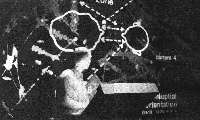
A review of Eno's lecture "Perfume, Defence and David Bowie's Wedding", from The Independent, Thursday 23rd July 1992, by Andy Gill

For easy access to particular areas of interest, click on the appropriate subject heading in this list.
It was called "Perfume, Defence and David Bowie's Wedding", but you only found that out at the end. All the tickets said was "Brian Eno Illustrated Lecture", which sounded intriguing enough to draw a sizeable proportion of London's intelligentsia on the wettest night of the year. The slide-lantern lecture is a form that has long since lapsed into disuse, but a mind as restlessly wide-ranging as Eno's seemed the perfect cause to revive it.
As it happened, the "Illustrated" part, a few comic diagrams excepted, turned out to be just a series of back-projected Pollock-esque action-paintings in fetching pastel shades, slowly combining and supplanting each other: soothingly non-specific visuals to match the slow, almost subliminally quiet progression of notes that served as soundtrack. It was not the best way to accompany a lecture, particularly since Eno is not the most natural of public speakers. Slow, monotonous and too softly-spoken - the beginning of his talk was interrupted several times by calls for increased volume - he has a hypnotist's cadences, perfect perhaps for sleep-tapes and stress-reduction. A bit like his records, in fact.
Certainly, compared with the monologues of Spalding Gray, whose desk and backdrop were echoed in this performance, Eno's talk lacked the tug of narrative expectation. This was not helped by the circuitous nature of the first section, which started out on perfume and the smells of civets - "Can you hear me now? Do you still want to, now we're getting on to the anal glands of cats?" he ad-libbed - and proceeded via musical notation to the theme of cultural relativism.
Thanks to David Hare, Michael Ignatieff and others, this is a long-buried chestnut that has recently been disinterred, and Eno's riposte to the elitism of the arbiters of high and low art needed to be made, and was elegantly done, even if there was more than a faint whiff of Vieux Chapeau about "Perfume". An account of his failed attempts at smell-mapping simply did not ring true - if he really believes that egg yolk smells the same as strawberries, it is hardly surprising he failed - but nevertheless constituted an entertaining link with the notion of musical notation, which, claimed Eno, was an equivalent area of empirical instability, very good for describing all the things we are not interested in, but hopeless for handling such contemporary elements as the infinite variety of guitar and synthesiser tones.
Critical interpretation, he suggested, was as much a battle-ground as historical interpretation, with cultural history being written by the victors; hence the rise to prominence of the curatorial aspects of art, in which a particular critic's or curator's over-view of culture now merits a greater prominence than the art-works themselves. But Eno's sideways digs at Bach seemed too flippantly contentious, especially coming from one whose systems-music experiments might be considered a modern development of Bach's thematic variations.
The talk reached its conclusion with an account of Eno's trip to Belgium to lecture EC ministers and functionaries on "The Future Of Culture", for which he was apparently allowed 30 minutes. It all depends, as Professor Joad used to say, what you mean by "culture", and Eno arrived at as cogent a one-line definition as any, holding that it was "everything we don't have to do", from music to painting to hairstyles. It was a reasonably satisfying conclusion after three-quarters of an hour of leisurely rumination. Unfortunately there were still two further sections remaining, and neither as interesting as the first.
For "Defence", a more purposive backdrop of words and letters overlaid the abstract squiggles, suggesting the imposition of hard facts over the abstract concerns of the first section. The talk, though, was on a loser from the start, as Eno attempted an interpretation of defence spending that hinged on altruism - politicians using the secrecy of national security projects as cover for funding research into vague areas of future scientific importance.
Diminishing returns applied all the more to the final section, an account of David Bowie's marriage ceremony which focused rather pointlessly on the minutiae of body movement, complete with diagrams. It seemed to exist simply to give Eno the opportunity for one of the worst jokes ever heard in Sadler's Wells, as he described the bride's stately progress up the aisle as "Kabuki-esque, yes; Noh, even." Always leave 'em laughing, as the old troupers say.